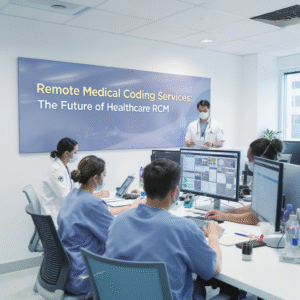The Importance of Documentation to Support Medical Coding
Medical Coding
Medical Coding
In the complex world of healthcare administration, medical coding serves as the critical bridge between clinical care and healthcare economics. Medical coders translate physician documentation into standardized codes that determine reimbursement, support quality reporting, and enable healthcare analytics. However, the accuracy and completeness of medical coding depends entirely on one fundamental element: comprehensive clinical documentation.

The Foundation of Accurate Medical Coding
Medical coding relies on detailed, specific, and complete documentation from healthcare providers. Without proper documentation, even the most skilled medical coder cannot assign accurate codes that reflect the true complexity and nature of patient care. This relationship between documentation and coding forms the backbone of healthcare revenue cycle management and clinical data integrity.
Quality documentation must capture the complete clinical picture, including the patient’s presenting symptoms, the provider’s clinical reasoning, diagnostic findings, treatment decisions, and patient outcomes. Each element of this documentation directly impacts the coding process and, ultimately, the healthcare organization’s ability to receive appropriate reimbursement for services rendered.
Impact on Healthcare Revenue and Compliance
Poor documentation practices can have devastating financial consequences for healthcare organizations. When documentation lacks specificity or completeness, coders must assign less precise codes, often resulting in lower reimbursement rates. For instance, documenting “chest pain” without further specification limits coding options compared to documenting “acute chest pain with radiation to left arm, suggestive of cardiac origin.”
Beyond financial implications, inadequate documentation creates significant compliance risks. Healthcare organizations face increasing scrutiny from payers and regulatory bodies who conduct post-payment audits. During these audits, the documentation must support every code assigned and every dollar claimed. Insufficient documentation can result in claim denials, overpayment recovery demands, and potential fraud allegations.
The Centers for Medicare & Medicaid Services (CMS) and other payers have implemented sophisticated audit programs that rely heavily on documentation quality. These audits can trigger widespread reviews of an organization’s coding practices, potentially affecting thousands of claims and millions of dollars in revenue.
Clinical Decision Making and Documentation Quality
Effective documentation does more than support coding accuracy; it reflects and supports quality clinical decision-making. When providers document thoroughly, they demonstrate their clinical reasoning process, justify their treatment decisions, and create a comprehensive record that supports continuity of care.
This comprehensive documentation benefits patient care by ensuring that all members of the healthcare team have access to complete information about the patient’s condition, treatment history, and care plan. It also supports clinical research, quality improvement initiatives, and population health management efforts.
Healthcare organizations that prioritize documentation quality often see improvements in clinical outcomes alongside better coding accuracy. This correlation exists because thorough documentation encourages providers to think systematically about patient care and ensures that important clinical details are not overlooked.

Technology Solutions and Documentation Improvement
Modern healthcare technology offers numerous tools to improve documentation quality and support accurate medical coding. Electronic Health Records (EHRs) can include clinical decision support tools, documentation templates, and automated prompts that help providers capture necessary information.
Computer-assisted coding (CAC) systems can analyze clinical documentation and suggest appropriate codes, but these systems are only as effective as the documentation they analyze. Natural language processing and artificial intelligence tools are increasingly sophisticated, but they cannot compensate for vague, incomplete, or inaccurate documentation.
Voice recognition software and mobile documentation solutions have made it easier for providers to capture detailed information at the point of care. These technologies can improve documentation completeness by reducing the administrative burden on clinicians and enabling real-time documentation.
However, technology alone cannot solve documentation problems. Healthcare organizations must combine technological solutions with comprehensive training, clear documentation policies, and ongoing quality monitoring to achieve sustainable improvement in documentation quality.
Building a Culture of Documentation Excellence
Creating excellent documentation practices requires a coordinated effort across the entire healthcare organization. This effort must begin with leadership commitment and extend through all levels of clinical staff. Organizations that successfully improve documentation quality typically implement comprehensive training programs, establish clear documentation standards, and create feedback mechanisms that help providers understand the impact of their documentation on coding accuracy and patient care.
Regular audits and feedback sessions help providers understand how their documentation affects coding outcomes and organizational performance. These educational initiatives should emphasize the connection between documentation quality, patient care, and organizational sustainability.
Physician champions and documentation specialists can play crucial roles in promoting documentation excellence. These individuals can provide peer-to-peer education, answer questions about documentation requirements, and help create sustainable documentation practices that fit within clinical workflows.
Future Considerations and Continuous Improvement
The healthcare industry continues to evolve, with new coding systems, regulatory requirements, and quality measures regularly introduced. Documentation practices must evolve alongside these changes to ensure continued accuracy and compliance.
Value-based care initiatives place additional emphasis on documentation quality, as these programs require detailed information about patient outcomes, risk factors, and care coordination activities. Healthcare organizations must prepare their documentation practices to support these evolving reimbursement models.

Continuous improvement in documentation quality requires ongoing monitoring, regular training updates, and adaptation to changing requirements. Organizations that view documentation improvement as an ongoing process rather than a one-time initiative are more likely to achieve sustained success in coding accuracy and compliance.
Conclusion
The importance of documentation to support medical coding cannot be overstated. Quality documentation serves as the foundation for accurate coding, appropriate reimbursement, regulatory compliance, and ultimately, sustainable healthcare operations. Healthcare organizations that invest in improving documentation quality will see benefits that extend far beyond coding accuracy, including improved patient care, better clinical decision-making, and enhanced organizational performance.
As healthcare continues to evolve toward value-based care and increased accountability, the relationship between documentation and coding will only become more critical. Organizations that recognize this relationship and take proactive steps to improve documentation quality will be better positioned for success in the changing healthcare landscape.
The path forward requires commitment from all levels of the organization, from executive leadership to front-line clinicians. By prioritizing documentation excellence, healthcare organizations can ensure accurate medical coding, optimize revenue cycle performance, and ultimately support their mission of providing quality patient care.



